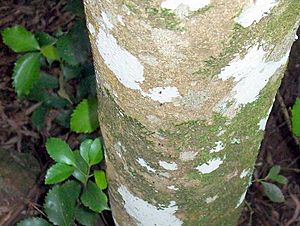Illawarra socketwood facts for kids
{{Speciesbox |name = Illawarra socketwood |image = Ilawarra Socketwood - leaves on stalk.jpg |image_caption = Illawarra socketwood, leaves from a fallen branch |status = EN |status_system = EPBC |genus = Daphnandra |species = johnsonii |authority = Schodde
|synonyms =
- Daphnandra micrantha (Tul.) Benth. sens. lat.
- Daphnandra species C
- Daphnandra sp. C sensu Harden (1990) novo-hollandicum
- Daphnandra sp. C Illawarra Schodde 3475
}
The Illawarra socketwood (scientific name: Daphnandra johnsonii) is a special and rare rainforest tree. It grows in the Illawarra area of eastern Australia. This tree is considered endangered, which means it's at high risk of disappearing forever.
Contents
Where the Illawarra Socketwood Lives
This tree usually grows in subtropical rainforests on volcanic soil. You can find it at elevations less than 150 metres above sea level, though sometimes it grows up to 350 metres high. It often lives near creeks or on dry, rocky slopes. You might also spot it in forests that have been disturbed or at the edges of rainforests. Its home range stretches from Berry, New South Wales in the south to Scarborough, New South Wales in the northern Illawarra region.
Naming and Family History
The Illawarra socketwood belongs to a very old plant family called Atherospermataceae. This family existed when the supercontinent Gondwana was still around, millions of years ago!
For a long time, this tree was thought to be part of another species, Daphnandra micrantha. But recently, scientists realized it was unique and gave it its own species name. The tree was named johnsonii after Lawrence Alexander Sidney Johnson, who collected the first sample in the Illawarra area. The scientist Richard Schodde officially named it.
The name Daphnandra comes from Greek words. Daphne means "bay laurel," and andros means "man." This refers to how the tree's anthers (the part of a flower that makes pollen) look similar to those of the bay laurel plant. The common name "socketwood" comes from a related tree, Daphnandra apatela. It's called this because where its larger branches join the main trunk, it looks like a "ball and socket" joint, similar to how your arm connects to your shoulder.
What the Illawarra Socketwood Looks Like
The Illawarra socketwood is a small to medium-sized tree. It can grow up to 20 metres tall and have a trunk about 30 centimetres wide. It has a wide, shady crown of leaves. The trunk is usually beige and smooth, with some darker bumps. Sometimes, you might see small leaves growing from the base of the trunk, which are called coppice leaves. Its branches are quite thick and have small pores called lenticels.
Leaves
The leaves of the Illawarra socketwood are shaped like an oval or an egg. They are usually 6 to 12 centimetres long and 1.5 to 6 centimetres wide. Each leaf has a sharp tip and grows in pairs opposite each other on the stem. They have 7 to 9 noticeable teeth along each side, but the bottom third of the leaf is smooth without any teeth. The underside of the leaf is a shiny pale green, while the top is a dull dark green.
You can see the veins more clearly on the underside of the leaf. The main vein (midrib) is raised on both sides of the leaf. There are usually six or seven pairs of side veins. The leaf stems are short, about 2 to 7 millimetres long. When old leaves are about to fall off, they turn pale and yellow while still on the tree.
Comparing Leaves with Common Sassafras
The leaves of the Illawarra socketwood can look similar to another tree called the common sassafras (Doryphora sassafras). Here's how to tell them apart:
- Illawarra socketwood leaves have one or two teeth per centimetre.
- The midrib (main vein) of the Illawarra socketwood leaf is raised on both the top and bottom surfaces.
- The side veins on the Illawarra socketwood are sharply angled, about 40 degrees from the midrib.
- The Illawarra socketwood leaf has a faint, "soapy" smell.
- Common sassafras leaves are usually more aromatic (smell stronger), have fewer coarse teeth, and their midrib is sunken on the top surface. They also feel thicker and heavier.
Flowers and Fruit
Tiny white flowers with pinkish-red edges appear in spring. They grow on long stems in clusters that are 3 to 8 centimetres long. The small parts of the flower (sepals and petals) are only about 1 to 3 millimetres long.
After flowering, the tree produces a woody, hairless fruit capsule. It's about 15 to 20 millimetres long and opens into two sections when ripe. The seeds inside are feathery.
How the Tree Reproduces
If the seeds are healthy, they can sprout easily within a month of being planted. However, in the wild, these trees often don't produce seeds that can grow. The fruits that don't have seeds are shorter and rounder. They contain many silky hairs, but no actual seeds. Some trees might have a mix of both seed-producing fruits and empty ones, but most trees only produce the empty fruits. Trees that produce only fertile (seed-filled) fruits are rare.
The Illawarra socketwood also has a hard time spreading to new areas on its own. Its main way of surviving is by growing new shoots from its base (suckering) or from cut stumps (coppice).
Conservation and Threats
Most of the 41 known groups of Illawarra socketwood trees are in danger. They are threatened by things like land being cleared for farms or new buildings, wild animals, weeds, uncontrolled fires, harmful chemicals, quarrying (digging for rocks), and building roads. Only two small groups of these trees are protected in special reserves. The largest and healthiest groups of trees are actually on private land.
Images for kids
-
Leaf of Illawarra socketwood (left), Common Sassafras (right)
See also
 In Spanish: Daphnandra johnsonii para niños
In Spanish: Daphnandra johnsonii para niños






